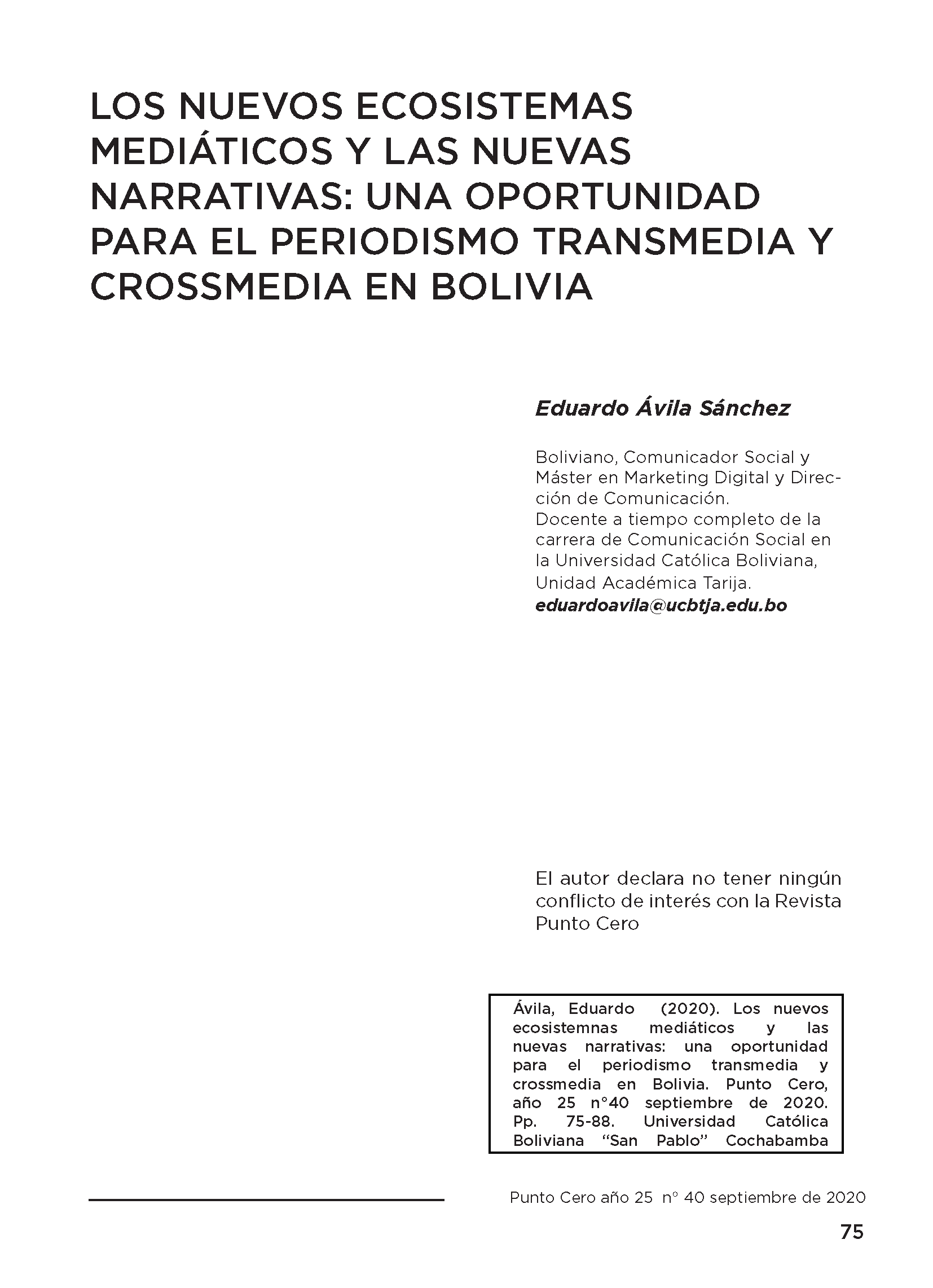The new media ecosystem and narratives: a real chance to transmedia and crossmedia journalism in Bolivia
DOI:
https://doi.org/10.35319/puntocero.20204016Keywords:
Media Ecosystem, Journalism, Transmedia, CrossmediaAbstract
From the technological changes through a traditional media real crisis, this paper looks forward an understanding of the emerging of internet as a fifth state and a theorical look of media ecology, which propose the concept of a media ecosystem, where media is converging, generating new communication and taking apart the linear logic of aged mass media theories. These ecosystems involve all media, new and traditional; but they have their own characteristics, that make, the before called audience, a new universe, user centered now known as prosumators. Therefore, new narratives have borned featuring multimedia and multitasking; the crossmedia and transmedia concepts have become in a new way of narrative, involving prosumators in its construction. Journalism as a practice and concept that is based on storytelling, dig in these changes and adapt them to its practice, and is arranged a new opportunity to get closer to the citizen. At last, paper analyze the current Bolivian situation on this transformation, and gets closer to indeed in its media ecosystem reality, getting to know if there is an auspicious environment to develop and dabble on these new narratives.
References
AGETIC. (2016). Encuesta nacional de opinión sobre Tecnologías de Información y Comunicación (TIC). https://agetic.gob.bo/pdf/dia_internet_encuesta.pdf
Canavilhas, J. (2011). El Nuevo Ecosistema Mediático. INDEX COMUNICACIÓN Revista Científica En El Ámbito de La Comunicación Aplicada, 1(1), 13–24.
Crisóstomo, R. (2016). ‘Fannibals’ ministéricos: el poder del ‘Fandom.’ Index Comunicación, 6(2), pp. 101–114.
De Nooijer, S. (2019). Transmedia Educational Narrative Design for Craftsmanship: How to Apply Transmedia Storytelling in Senior Secondary Vocational Education Curricula.
Flores, J. y Aguado, G. (2007). Blogs, Sociedad y Quinto Poder. Anagramas, 5, pp. 112–124.
Hurtado, Á. (2019). Nadie se Cansa , Nadie se Rinde La “Generación Pititas” y la Comunicación Paralela. APORTES, 27, pp. 9–20.
Ivars, B. y Martínez, F. (2020). Interactivity in Fiction Series as Part of Its Transmedia Universe: The Case of Black Mirror: Bandersnatch. In B. Peña-Acuña (Ed.), Narrative Transmedia, pp. 7–20. IntechOpen.
Larrondo, A. (2016). El Relato Transmedia y su Significación en el Periodismo. Una Aproximación Conceptual y Práctica. Trípodos, 0(38), pp 31–47.
Manovich, L. (2005). El Lenguaje de los Nuevos Medios de Comunicación. PAIDOS IBÉRICA S.A.
Mc Luhan, M. y Powers, B. (1995). La aldea global (Tercera). Editorial GEDISA.
Meso, K.; Rivero S., Tous, A. y Larrondo, A. (2015). Del porqué las redes sociales revolucionan la agenda setting de los medios. In Periodismo Actual y Futuro: Investigación, Docencia e Innovación (pp. 460–475). Barcelona: Universitat Pompeu Fabra : Sociedad Española de Periodística.
Moya, E. (2018). Prosumo, Swarming y Transme dia: Hacia un nuevo concepto de Stakeholder. ICONO14. Revista Científica de Comunicación y Tecnologías Emergentes, 16(2), pp. 25–50. DOI: https://doi.org/10.7195/ri14.v16i2.1213
Ossorio M. (2016). Periodismo Multiplataforma: Transmedia y Crossmedia. TecCom Studies: Estudios de Tecnología y Comunicación, 5(7), pp. 84–92.
Peñaranda, R. (2014). Control Remoto: de cómo el Gobierno de Evo Morales Creó una Red de Medios Paraestatales y un Plan para Acosar a la Prensa Independiente.
Ramonet, I. (2004). Información, Comunicación y Globalización: El Quinto Poder. Chasqui: Revista Latinoamericana de Comunicación, 88, pp. 26–31.
Robledo, K.; Atarama, T. y Palomino, H. (2017). De la Comunicación Multimedia a la Comunicación Transmedia: Una Revisión Teórica sobre las Actuales Narrativas Periodísticas. Estudios Sobre El Mensaje Periodístico, 23(1), pp. 223–240. DOI: https://doi.org/10.5209/ESMP.55593
Ruiz, S. (2015). Las Redes Sociales en Internet como Fuente de Información para los Jóvenes frente a los Medios Convencionales. In Periodismo Actual y Futuro: Investigación, Docencia e Innovación, pp. 585–599. Barcelona: Universitat Pompeu Fabra : Sociedad Española de Periodística.
Scolari, C. (2013). Narrativas Transmedia: Cuando todos los medios cuentan. DEUSTO S.A. EDICIONES.
Scolari, C. (2015a). Ecología de los medios: Entornos, evoluciones e interpretaciones. GEDISA.
Scolari, C. (2015b). Los Ecos de McLuhan: Ecología de los Medios, Semiótica e Interfaces. Palabra Clave, 18(4), pp. 1025–1056. DOI: https://doi.org/10.5294/pacla.2015.18.4.4
Yuste, B. (2015). El Nuevo Ecosistema Mediático Digital Alternativo a los Medios. Communication Papers, 4(08), p. 41. DOI: https://doi.org/10.33115/udg_bib/cp.v4i08.22066

Downloads
Published
How to Cite
Issue
Section
License
Copyright (c) 2020 Revista Punto Cero

This work is licensed under a Creative Commons Attribution-NonCommercial 4.0 International License.








